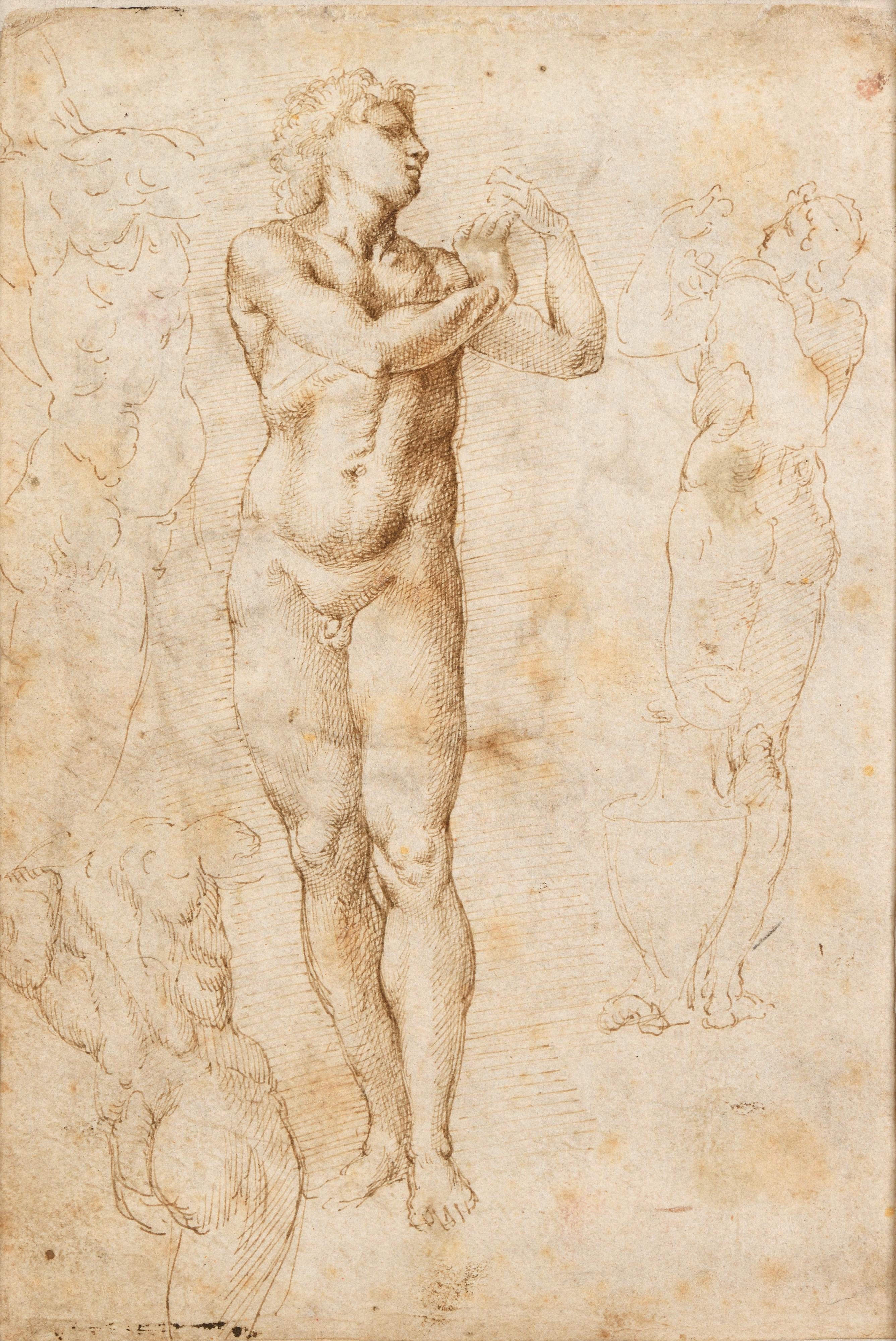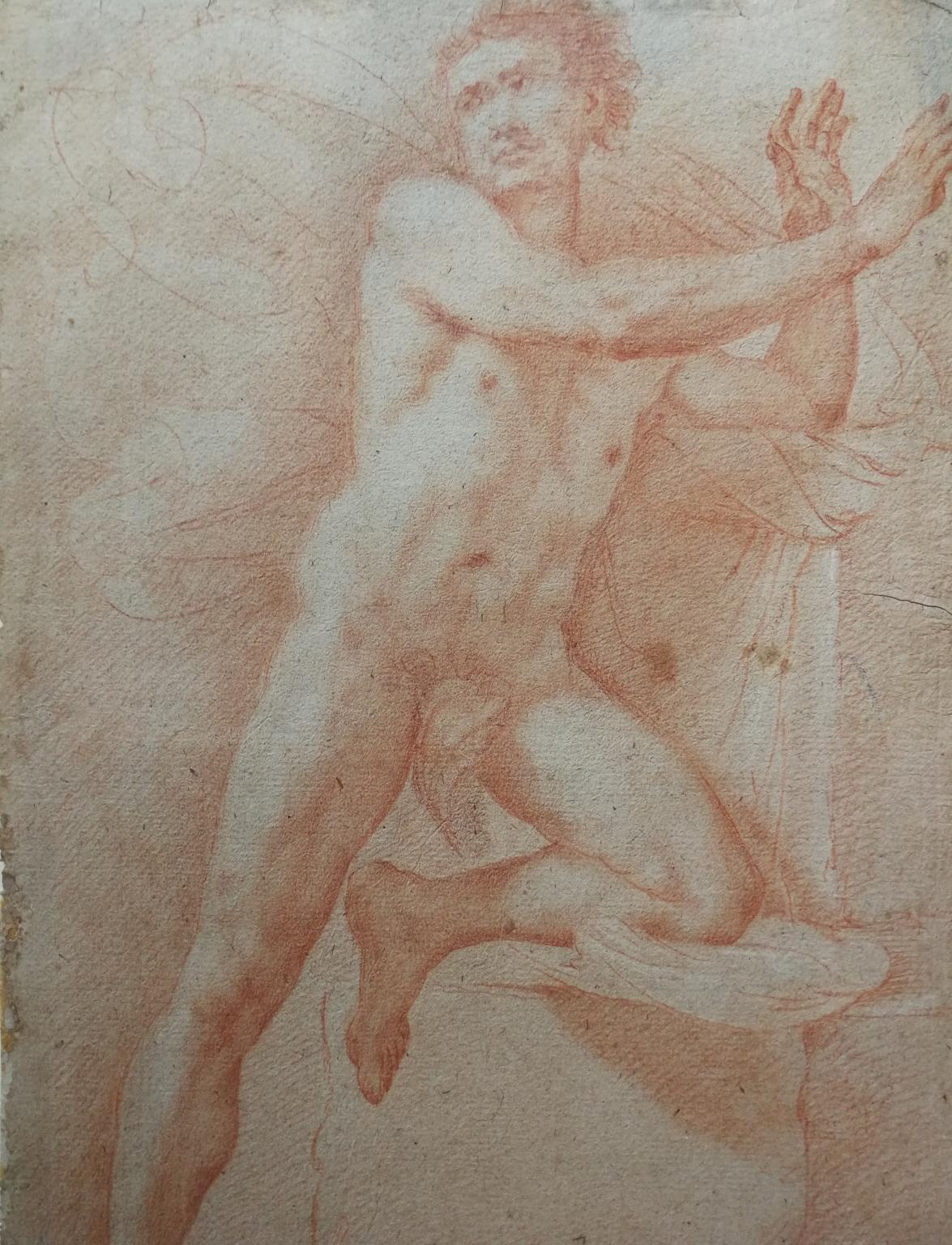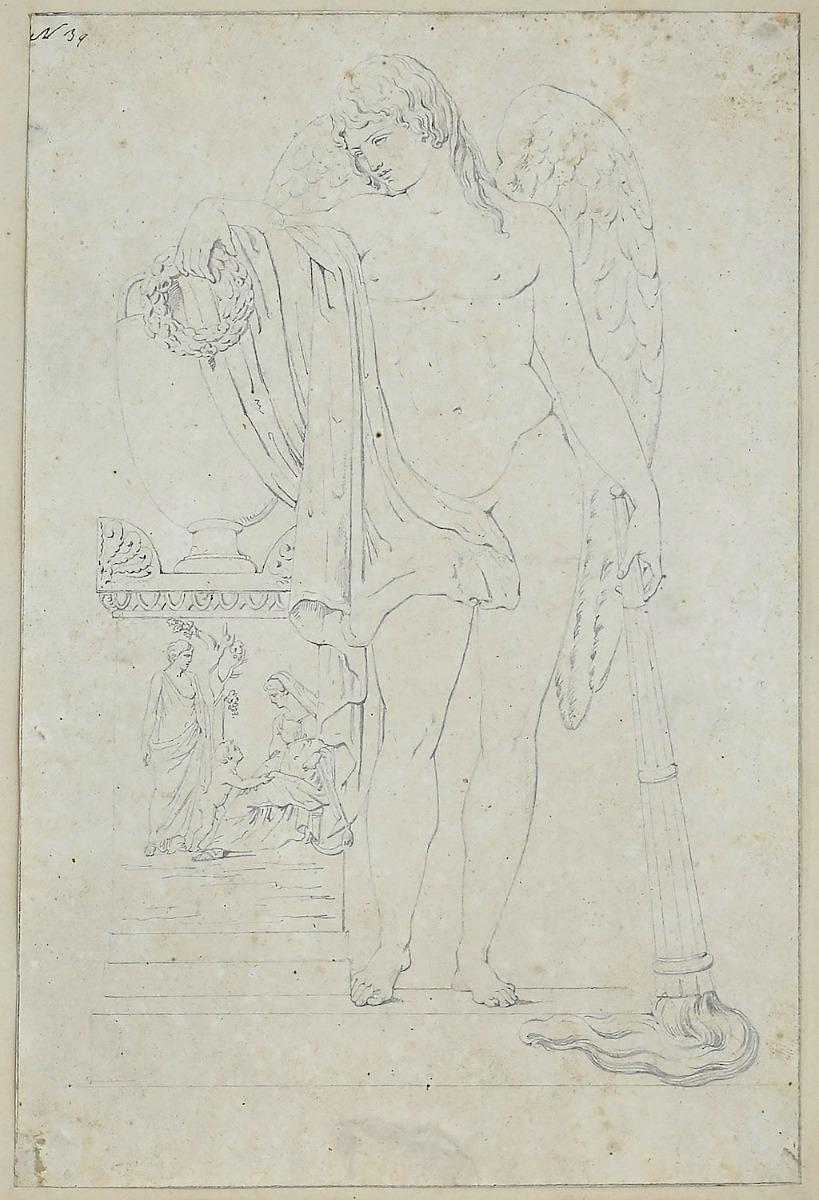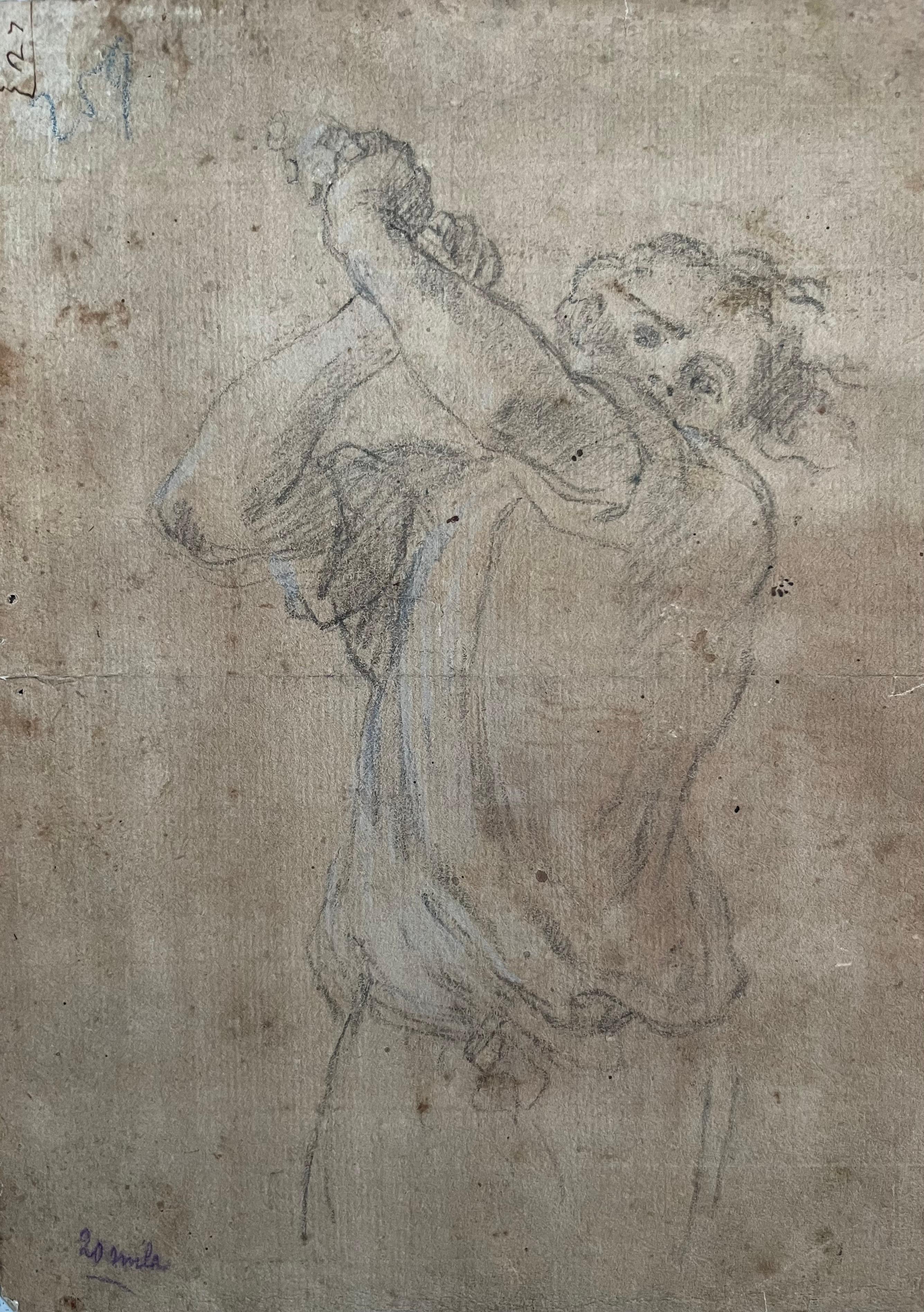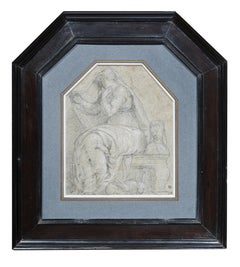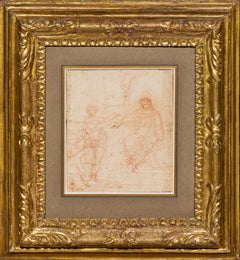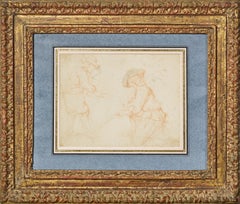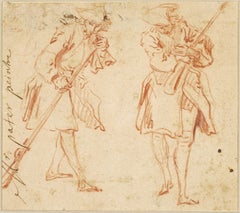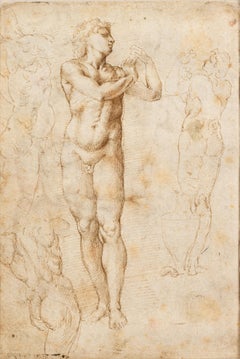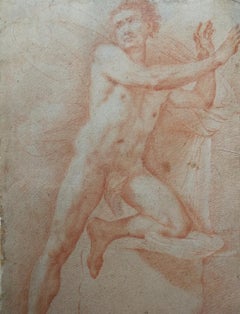Items Similar to Study of a Fate at mid-body, a red chalk attributed to Giovanni da San Giovanni
Want more images or videos?
Request additional images or videos from the seller
1 of 8
Study of a Fate at mid-body, a red chalk attributed to Giovanni da San GiovanniCirca 1635
Circa 1635
$20,304.07
£15,045.05
€17,000
CA$28,087.31
A$30,954.16
CHF 16,205.53
MX$380,214.91
NOK 203,626.02
SEK 190,577.75
DKK 129,467.58
About the Item
This spectacular red chalk drawing depicts an elderly woman, her eyes bulging, her hand stretched out towards the sky. This disturbing character, who seems close to dementia, and the elongation of her arm with its Mannerist overtones, plunge us into the Florentine artistic milieu of the first half of the 17th century. The proximity of this drawing to some characters in the fresco in the Pitti Palace representing The Muses, Poets and Philosophers chased from Parnassus, the last masterpiece of Giovanni da San Giovanni, leads us to propose an attribution to this artist and a dating of around 1635-1636.
1. Giovanni da San Giovanni, the painter of contradiction
We take here the title of the monography dedicated to the artist by Anna Banti in 1977, which remains the reference book for this artist. The son of a notary, Giovanni Mannozzi, known as Giovanni da San Giovanni, abandoned his studies to go to Florence at the age of sixteen, where he entered the studio of Matteo Rosselli (1578 - 1650) around 1609 and enrolled in the Academy of Drawing Arts in 1612. Around 1615 he produced his first known works, mainly frescoes for the city's tabernacles. He became famous in Florence for his originality, combining an obsessive application to the study of drawing and the reading of poetry and history with a disheveled appearance. Between 1619 and 1620 he decorated the facade of the Antella Palace in Piazza Santa Croce, a decoration that still partly survives today.
The death of Cosimo II in 1621 put an end to the Florentine building activity and Giovanni da San Giovanni left for Rome to find other sponsors with the painter Francesco Furini. In particular, he made friends with Cardinal Guido Bentivoglio, for whom he decorated several rooms in his palace, which led him to leave Rome in 1628 to decorate the Bentivoglio family's palace in Gualtieri in Emilia Romagna.
After a few years spent on various building sites in the Tuscan countryside, he returned to the Medici orbit around 1633, creating a ceiling for Christine de Lorraine at her villa La Quiete. In 1635 he received his last official commission: on the occasion of his marriage to Vittoria della Rovere, Ferdinand II de' Medici entrusted him with the decoration of a large room, also known as the Salone degli Argenti, in the summer appartment on the ground floor of the Palazzo Pitti.
Giovanni da San Giovanni and his assistants (among them the young and promising Volterrano) decorated the ceiling and the vast wall opposite the windows with frescoes celebrating the glory of the Medici family. However, Giovanni da San Giovanni preferred to accept another project with Lorenzo Pucci before completing the decoration of this room; he was then dismissed by the Grand Duke and deprived of his income. Very affected by his disgrace, he died on December 9th, 1636, aged forty-four, of a badly treated gangrene in his knee.
2. Description of the red chalk drawing
The interpretation of our drawing is difficult: an elderly woman with messy hair and a desperate look in her eyes, her back slightly arched, holds a leaflet in her right hand while her left arm rises in the air, as if to take Heaven to task. The whole character is treated with great elegance and the masterly aspect of this slightly derisory movement is further reinforced by the elongation of the arm in relation to the rest of the body.
The presence of a leaf in her right hand could link this representation to that of Morta (Atropos in Greek), one of the three Fates who is sometimes represented reading the book of life, or cutting the thread of life.
3. Related artworks
We have not found any work directly related to this drawing, but the character seems to us to be quite close to the dishevelled harpy represented behind the poetess Sapho, who flees with a violin in her hand, in the fresco representing The Muses, the Poets and the Philosophers chased from Parnassus take refuge in Tuscany (seventh photo of the Gallery). This fresco was executed between 1635 and 1636 by Giovanni de San Giovanni on the eastern wall of the Salone degli Argenti in the Pitti Palace in Florence.
To be noted is the disproportionate length of the harpy's arm.
The three Fates are also represented on the ceiling of the same room (last photo of the Gallery), and this time the terrible Morta appears with her arms outstretched and her terrifying face, cutting an oak branch, under the protection of Juno and Venus, and thus accomplishing the union between the Medici family and that of the della Rovere (whose name means oak in Italian).
We also find in a detached fresco from Palazzo Pucci depicting Night and Dawn , one of Giovanni da San Giovanni's last works, a figure with her arm outstretched and her bosom bared. Although this is a beautiful young woman and not a terrifying old one, it is interesting to note that this relatively unusual pose recurs very repeatedly in Giovanni da San Giovanni's last works, justifying in our view the attribution of our sanguine to this artist and a proposed dating of around 1635-1636.
4. Provenance
This drawing comes from the collection of Doctor Gaud, a medical doctor born on July 18th, 1940 in Saint-Tropez, who sold most of his collection at Sotheby's in Monaco on June 20th, 1987, and then a few other drawings (which included this drawing) at the Piasa sale on March 26th 2010. He was particularly interested in Italian drawings from the Renaissance to the Baroque period, favouring singular pieces by little known artists.
This drawing is sold unframed but we can propose some framing options.
Main bibliographical references :
Anna Banti - Giovanni da San Giovanni pittore della contraddizione - Sansoni Firenze 1977
Silvia Benassai - Mara Visonà Quiete invenzione e inquietudine - Centro Di Firenze 2011
- Attributed to:Giovanni Mannozzi, called Giovanni da San Giovanni (1592 - 1636, Italian)
- Creation Year:Circa 1635
- Dimensions:Height: 10 in (25.4 cm)Width: 7.75 in (19.69 cm)
- Medium:
- Movement & Style:
- Period:
- Framing:Framing Options Available
- Condition:Red chalk – 10” x 7 3/4” (255 x 196 mm) - Framed: 16 5/16” x 14” (41.5 x 35.5 cm) Provenance: Michel Gaud (stamp lower left L. 3482) - Piasa sale on March 26th, 2010 (lot 5).
- Gallery Location:PARIS, FR
- Reference Number:1stDibs: LU1568211886102
About the Seller
5.0
Vetted Professional Seller
Every seller passes strict standards for authenticity and reliability
Established in 2020
1stDibs seller since 2021
10 sales on 1stDibs
Typical response time: 3 hours
- ShippingRetrieving quote...Shipping from: PARIS, France
- Return Policy
Authenticity Guarantee
In the unlikely event there’s an issue with an item’s authenticity, contact us within 1 year for a full refund. DetailsMoney-Back Guarantee
If your item is not as described, is damaged in transit, or does not arrive, contact us within 7 days for a full refund. Details24-Hour Cancellation
You have a 24-hour grace period in which to reconsider your purchase, with no questions asked.Vetted Professional Sellers
Our world-class sellers must adhere to strict standards for service and quality, maintaining the integrity of our listings.Price-Match Guarantee
If you find that a seller listed the same item for a lower price elsewhere, we’ll match it.Trusted Global Delivery
Our best-in-class carrier network provides specialized shipping options worldwide, including custom delivery.More From This Seller
View AllAllegory of Chastity, a drawing attributed to G. Porta with great provenance
Located in PARIS, FR
This magnificent drawing from the Venetian Renaissance intrigues us in many ways. It depicts an allegorical composition whose meaning partly escapes us: a veiled figure seated on a stone bench (which we have identified as Chastity), seems to be turning away from a woman's bust beside her, below which are two rabbits, a traditional allegory of fertility, but also sometimes of lust.
This drawing, executed on blue paper, undoubtedly belongs to the Venetian Renaissance. The inscriptions on the back of the old mounting board indicate the various attributions considered by its last owner, the British painter and art historian Sir Lawrence Gowing. We have retained the attribution to Giuseppe Porta proposed by art historian John Arthur Gere as the most relevant.
We were incredibly fortunate to find a hexagonal frame of a very similar format for this drawing, the upper corners of which were formerly cut (irregularly). This 17th-century Dutch frame comes from an aristocratic collection in Lombardy, and creates a kind of fascinating chase around this Venetian drawing...
Category
16th Century Figurative Drawings and Watercolors
Materials
Chalk
Studies for the Judgment of Solomon, a double-sided drawing by Simone Cantarini
Located in PARIS, FR
In this double-sided red chalk study, Simone Cantarini offers us a double reflection on the theme of the Judgment of Solomon. This sheet reveals his precise style and his sense of de...
Category
1640s Old Masters Figurative Drawings and Watercolors
Materials
Chalk, Laid Paper
Study for a Hunting Scene, a red chalk sketch attributed to Karel du Jardin
Located in PARIS, FR
We would like to thank Carolina Trupiano Kowalczyk for suggesting this attribution to Karel du Jardin after direct examination of the artwork. Her study of the drawing (in Italian), ...
Category
1650s Old Masters Figurative Drawings and Watercolors
Materials
Chalk, Ink, Laid Paper
Two military studies, a preparatory red chalk drawing by Jean-Baptiste Pater
By Jean-Baptiste Pater
Located in PARIS, FR
As Florence Ingersoll-Smouse wrote in 1921 in her book devoted to Jean-Baptiste Pater, "a painter of the Fête galante, Pater is interesting both by his intimacy with Watteau, to whom many of his works are still attributed, and by his own value as an artist.” This sanguine, full of life and spontaneity, is typical of the preparatory studies made by the painter to be used later in the composition of his paintings.
1. Jean-Baptiste Pater, pupil and disciple of Antoine Watteau
Antoine Pater, Jean-Baptiste's father, belonged to the petty bourgeoisie of Valenciennes where he worked as a merchant-sculptor. His brother Jacques was a local painter who was probably involved in his nephew's training. Born on December 29, 1695, Jean-Baptiste Pater was first trained with Jean-Baptiste Guider, a local painter whose death in 1711 was probably the reason for Jean-Baptiste’s departure alongside Watteau, who was visiting Valenciennes. Watteau's difficult character led to their separation in 1713.
Back in Valenciennes, Jean-Baptiste Pater encountered difficulties with the powerful Corporation of Saint-Luke (to which he refused to belong) which forced him to return to Paris in 1718. He reconciled with Watteau shortly before his death (on July 18th 1721), inherited the commissions that Watteau had been unable to fulfil and completed some of his paintings.
Pater was accepted by the Académie Royale in 1725 but did not produce his reception painting The soldier’s revels until three years later. Throughout his brief career (he died at the age of forty on July 25th 1736), he mainly had a clientele of amateurs and received only one royal commission, shortly before his death.
2. Description of the drawing and related artworks
Pater had adopted his master Watteau's method of composition. His study drawings were carefully glued in a notebook and were used to animate his compositions.
His paintings sometimes suffer from a somewhat artificial composition, since the figures seem to be pasted one next to the other. This point has also been made about Watteau’s.
The theme of military scenes (which was at the time included in the genre of Fêtes galantes!) was one of Pater’s favourite subjects. Together with the Bathing Women...
Category
1720s Old Masters Figurative Prints
Materials
Chalk
Study for a Frontispiece, a baroque drawing by Giovanni Antonio Pellegrini
By Giovanni Antonio Pellegrini
Located in PARIS, FR
This masterly frontispiece study, executed with a very sure hand, testifies to the survival of the great Baroque taste in 18th century Venice. It could be one of the very last works by Giovanni Antonio Pellegrini: the few lines that cross the papal arms evoke those of Benedict XIV, who became pope in 1740, one year before the artist's death.
1. Giovanni Antonio Pellegrini and the European influence of Venetian history painting in the 18th century
Giovanni Antonio Pellegrini was born in Venice in 1675 and trained in the studio of the Milanese painter Paolo Pagani (1655 - 1716). Pagani, who had been living in Venice since 1667, took him to Moravia and Vienna from 1690 to 1696. After a stay in Rome from 1699 to 1701, Pellegrini married Angiola Carriera in 1704, the sister of the great pastelist Rosalba Carriera.
From 1708 onwards, Pellegrini left Venice and began an extensive tour of Europe: he worked in England between 1708 and 1713, where he met great success, particularly at Kimbolton Castle and Castle Howard. He then worked in Germany and the Netherlands, then in Bohemia and Austria, before returning briefly to England in 1719. In 1720 he was in Paris where he decorated the ceilings of the Royal Bank for John Law...
Category
1740s Old Masters Figurative Drawings and Watercolors
Materials
Ink
The Martyrdom of Saint Bartholomew, a preparatory drawing by Alessandro Casolani
Located in PARIS, FR
This powerful pen and brown ink wash drawing is a study for an altarpiece depicting The Martyrdom of Saint Bartholomew. Signed and dated 1604, it was painted at the end of his life b...
Category
Early 1600s Old Masters Figurative Drawings and Watercolors
Materials
Ink, Pen
You May Also Like
Studies of the Galli Statue and of an Ignudo
Located in Paris, Île-de-France
Florentine School, early 16th century
Studies of the Galli Statue and of an Ignudo
Pen and brown ink on laid paper
19.1 × 13 cm
Executed c. 1510–1520
Unsigned
This remarkable doub...
Category
16th Century Old Masters Nude Drawings and Watercolors
Materials
Ink
Francesco Furini Sanguine Drawing before 1642
Located in Florence, IT
Preparatory Drawing (sanguine on paper, 42 x 28 cm) by Francesco Furini for the making of the Saint Sebastian, ordered by the prince Lorenzo de' Medic...
Category
1640s Baroque Nude Drawings and Watercolors
Materials
Paper, Color Pencil
Old Masters Chalk Drawing, 17th Century Italian Sanguine on Paper
Located in London, GB
Sanguine chalk on paper
Image size: 7 x 8 1/2 inches (18 x 22 cm)
Acid free cut-out mount
This 17th century drawing depicts a reclining woman with her back.
The Sanguine chalk that...
Category
17th Century Italian School Figurative Drawings and Watercolors
Materials
Paper, Chalk
Old Master French Sanguine Drawing of Hercules
Located in Pasadena, CA
Old Master, French School red chalk drawing on paper is not signed .
Done in Sanguine on paper the nude appear like Hercule . The feel and look of the works while academic studies a...
Category
17th Century Baroque Nude Drawings and Watercolors
Materials
Archival Paper
Study for Statue - Pencil Drawing by Giovanni Fontana - Early 17th Century
By Giovanni Fontana
Located in Roma, IT
Study for Statue is an original drawing in pencil on paper, realized by the architect and engineer Giovanni Fontana (1540-1614).
The state of preservation of the artwork is good exc...
Category
Early 17th Century Renaissance Figurative Drawings and Watercolors
Materials
Pencil
Roman School (circa 1590–1620) - Study Of An Executioner
Located in Paris, Île-de-France
Roman School (circa 1590–1620)
Study of a Male Executioner
Black chalk on laid paper,
275 x 199 mm
Unsigned
Formerly Giancarlo Sestieri Collection
This dynamic figure study, exe...
Category
16th Century Old Masters Nude Drawings and Watercolors
Materials
Chalk, Laid Paper
More Ways To Browse
Old Master Italian Drawings
Italian Woman Nude
Body Of Art
Old Medici
Nude Reading
Greek Red Figure
Antique Medical Art
Nude Paintings Venus
Greek Philosophers
Orange Pucci
The Fates
Antique Wall Fresco
Red Chalk Drawing
Pitti Palace
Three Fates
Francesco Furini
Academic Male Nude Paintings
1930s Modern Painting Male Nude
